The Charlotte-Genesee Lighthouse
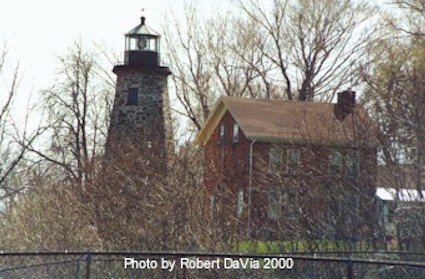
Built in 1822 on a bluff overlooking the mouth
of the Genesee River, the
Charlotte Genesee
Lighthouse is the second oldest lighthouse on the Great Lakes. The cost to build the
lighthouse, a 20-foot by 34-foot two-room keeper’s house and a 52-foot well, was
$3,301.00.
It was built in seven months.
Like most lighthouses on the Great Lakes, it was
operated only during the summer season, which changed as budgets and other conditions
changed.
Giles Holden, the first permanent
keeper, was assisted by Henry Newcomb.
The octagonal sandstone tower is
forty-foot high, from ground level to the top of the stone walls, and has a focal plane of
85-feet above water level.
It has a diameter
of 23-feet at the base and 11-feet at the top, and was illuminated with 10 Argand Lamps
with silvered reflectors, fueled by whale oil, and arranged in a semi-circle so that their
beams spread from shore to shore.
The
original octagonal domed lantern had 144 panes of glass (each side had eighteen panes of
glass 14” x 12”), and a copper roof over iron rafters to form a funnel for smoke
to escape.
The vent at the top was rotated by
a weather vane so the hole for venting smoke would always be leeward.
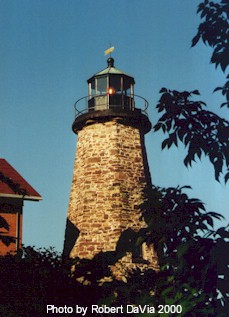
In
1838, a secondary light was installed at the end of the west pier.
This light, as well as the main light, were
maintained by the same keeper.
In 1854, a
sixth-order Fresnel lens was installed in the secondary light.
As part of a program to modernize all U.S.
Lighthouses, extensive changes were made to the main tower in 1858.
A non-rotating fourth-order Fresnel lens, imported
from France, was used until 1881.
It was
installed over a single Argand oil lamp with no reflectors, and was visible for up to 20
miles.
The old multi-paned lantern was
replaced with a lantern of ten panes, made of cast iron and glass, and was a standard
fourth through sixth order lantern used on many lights.
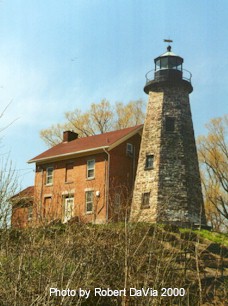
Changes to the tower included a new cast iron deck laid on top of
the original stone cap.
The windows and door
were replaced with iron; the wooden stairs were removed and replaced by a circular cast
iron stairway.
To support the stairs, an
inner circular column of bricks was built.
The
masonry was repointed and whitewashed. $2,000
was spent on these upgrades.
In 1863, the original keeper’s house
was replaced with the current house.
A
passageway was built to connect the house with the tower, but was removed in the early
1900’s. Keeper’s houses were well
built homes for their day.
The government
felt that it was important to provide housing for the keeper’s to be able to maintain
control of the keeper and the job of maintaining the light.
It was too important to be left to a civilian – keeper’s were
expected to maintain the property to very strict standards. The house served as home for the keeper until
1940, when it became the home of the Officer in Charge of the Coast Guard.
The Coast Guard assumed responsibilities for the
lighthouse, Life Saving Service, and the Revenue Service.
In 1881, the use of the light in the main
lighthouse was discontinued.
The problem was
that the lighthouse was built before the piers, first built in 1829.
When the piers drastically changed the mouth of
the port, the light was moved.
The
fourth-order Fresnel lens was moved to a new cast iron beacon at the end of the west pier.
This was done despite protests from the lake
captains, who argued that the position of the lighthouse on the bluff was higher and
therefore much more visible.
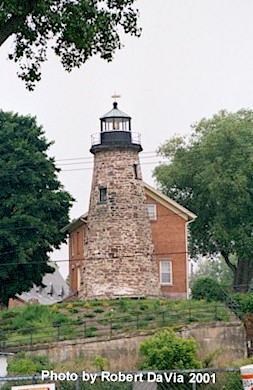
In 1884, a new frame lighthouse tower was
built on the west pier.
The lantern structure
from the lighthouse was moved to the new beacon to house the Fresnel lens.
A fog bell was also added to the west pier tower.
This was replaced ten years later by a steam fog
horn.
Windows in the old lighthouse were
eventually sealed with concrete slabs.
In
1909, a compressed air foghorn replaced the steam fog horn. (It is also reported that the
light was converted to batteries at this time, and that the batteries were charged, and
the air horn run by, a gasoline engine.)
In
1931 an automated electric system was installed in a new steel tower on the west pier.
In 1965, the
United States Coast Guard considered demolishing
the original lighthouse tower.
Students of
Charlotte High school organized a campaign and preserved the landmark.
The lighthouse was placed on the state and
National Registers of Historic Places, and declared a City of Rochester landmark, in 1974.
In 1982, it was turned over to the Charlotte
Community Association, which branched off to the Charlotte-Genesee Lighthouse Historical
Society.
Tours began in 1984, when a wooden
replica lantern, built by Edison Tech High School students, was installed.
The rotating fourth-order Fresnel lens currently
installed is on loan from the Cleveland office of the Coast Guard, and was built in the
United States.
In 1991, the Lighthouse Museum
received a permanent charter from
New York State,
and a 20 year lease from the
County of Monroe.
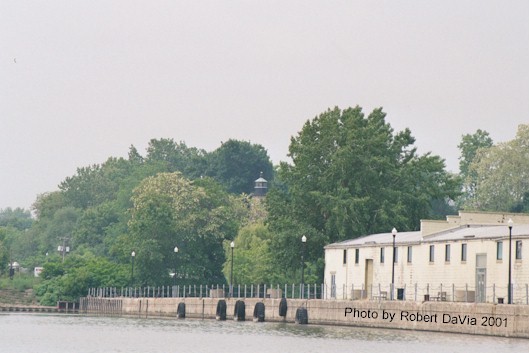
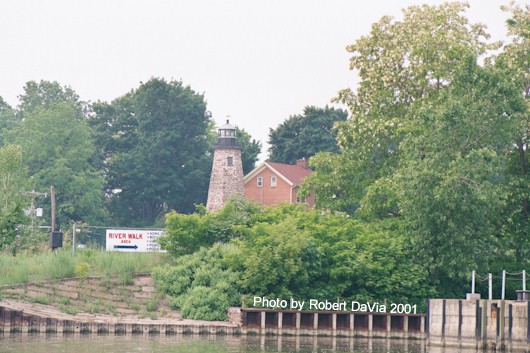
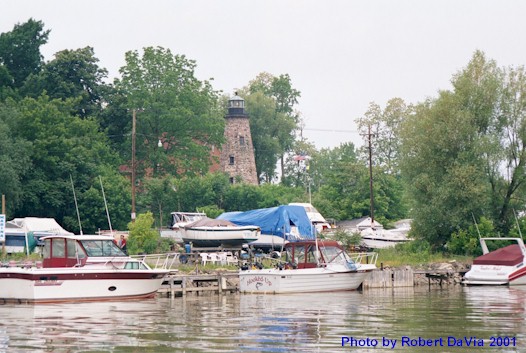
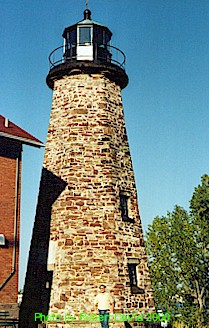
Return to
the New York State Page
Return to the: Alphabetical Listing or the Listing by States









